| 1 | Elephant trunk snake |
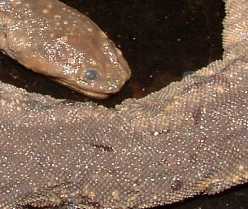
A strong candidate for the weirdest looking snake on Earth. Elephant trunk snakes live in Indonesia and Malaysia, and are distinguished by their baggy skin which hangs off their body like they’ve just been on a wildly successful diet. This snake looks like it needs to tie a belt around itself, and is so baggy that when it swallows large prey, you can barely see the usual bulge. Combined with their grey scales, the elephant trunk image is complete.
Everything goes to plan when they’re younger, as elephant trunk snakes start off with white patches, and sleeker scales which allow them to move on land. But a few months in, the transformation starts. The bagginess rises exponentially, and the snake suddenly becomes stranded in the water, particularly coastal areas and mangroves. The bagginess allows it float, while making shuffling on land extremely difficult.
Elephant trunk snakes are also weird for having a far thicker body than head. They reproduce at a snail’s pace, producing a clutch of hatchlings (averaging at 30) every eight years. They can also reproduce 7 years after their last contact with a male.
| 2 | Malagasy leaf nosed snake |
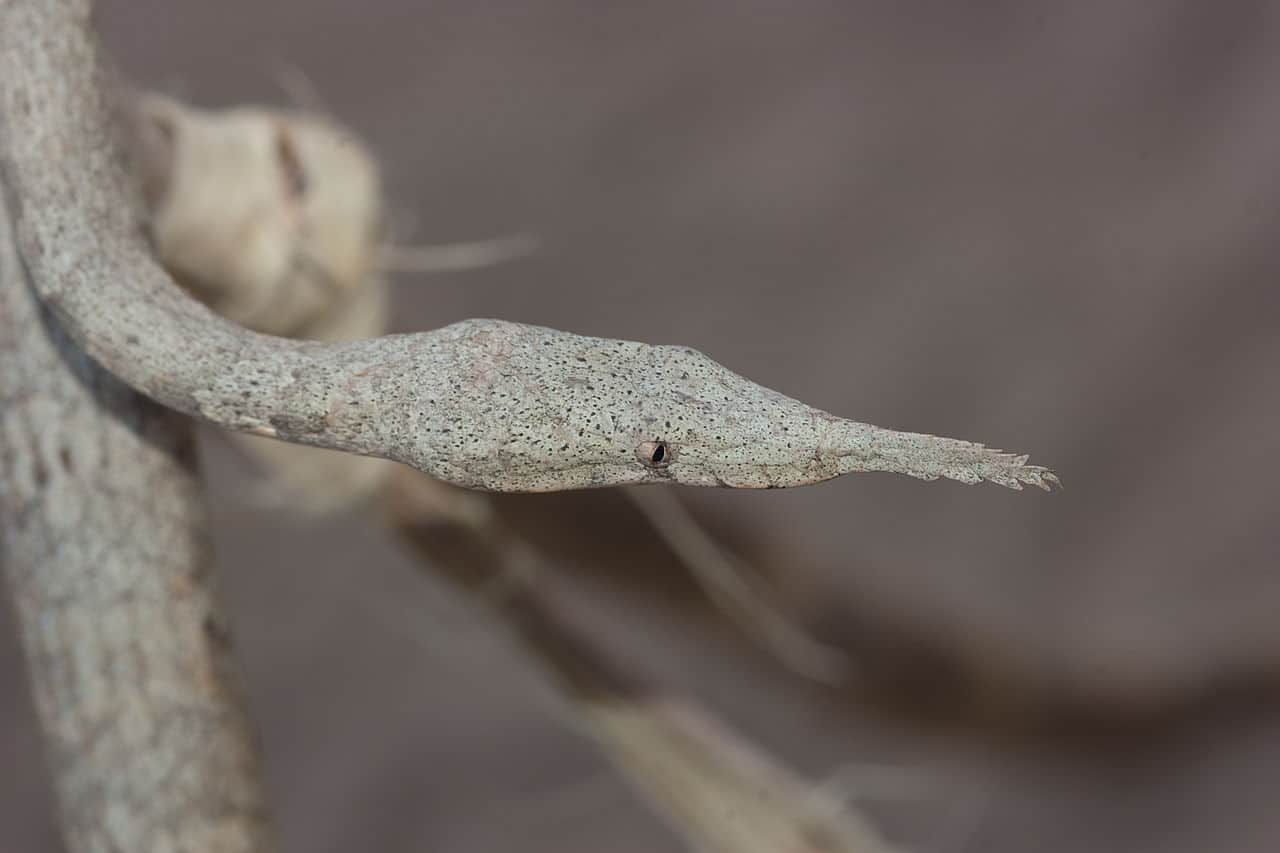
Being isolated and cut off has turned Madagascar into a red hot pressure cooker of weird evolutionary spirals. There’s no better example of this than the 100cm Malagasy leaf snake. This snake lives in forests, and looks weirder than all the snakes of western Europe combined. While rattlesnakes grew rattles and pythons learnt to constrict, Langaha madagascariensis spent millions of years on Madagascar slowly becoming more and more leaf like. This takes the form of a leafy nose appendage whose exact purpose is unknown. It could be designed for camouflage, to funnel water off their scales, for hunting, or anything. This leafy nose look like it could snap off, but is made from hard scale extensions.
Both males and females have this wacky appendage, but with females (pictured above) it’s even more elaborate, while in males, it’s usually pointier. Malagasy leaf snakes aren’t born with this leafy appearance, but they only take 36 hours to assume their lifelong shape. They’re born from eggs, and the appendage is folded down initially so that they can use an egg tooth to hack their way free.
While Langaha madagascariensis is the main leaf-nosed species, Madagascar also hosts two others: L. alluaudi and L. pseudoalluaudi. These are very poorly documented.
| 3 | Arabian sand boa |
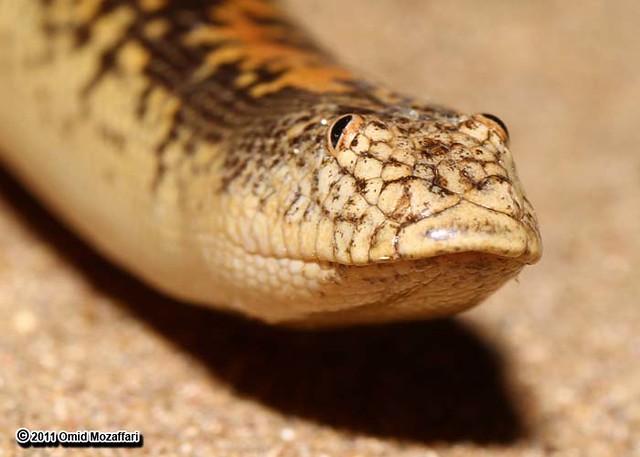
The Arabian sand boa measures 30-45cm, and is a non-venomous constrictor. It’s probably the least scary snake on Earth, looking more like a Saturday morning cartoon come to life than anything else. Its eyes look like they’ve been knitted on with a grandma’s sowing box, and its pupils are a weird triangular shape.
The final piece of the puzzle is the orientation. Because the Arabian sand boa buries itself in sand dunes in order to hunt passing lizards, its eyes have evolved to angle upwards. Pointing downwards into the Earth’s core would do it no good. As a result, its eyes are on top of its head rather than facing forward. The Arabian sand boa looks permanently dazed and confused, a far cry from the boa constrictor it is distantly related to. Its red and black colours are also striking, contrasting with a pale yellow belly, and its smooth body looks like a wooden carving.
Your best chance of seeing this wacky snake is to park your car and walk into the Saudi Arabian desert. However, bear in mind that they often bury themselves so deep that all you can see is an eyeball.
| 4 | Tentacled snake (Erpeton tentaculatum) |
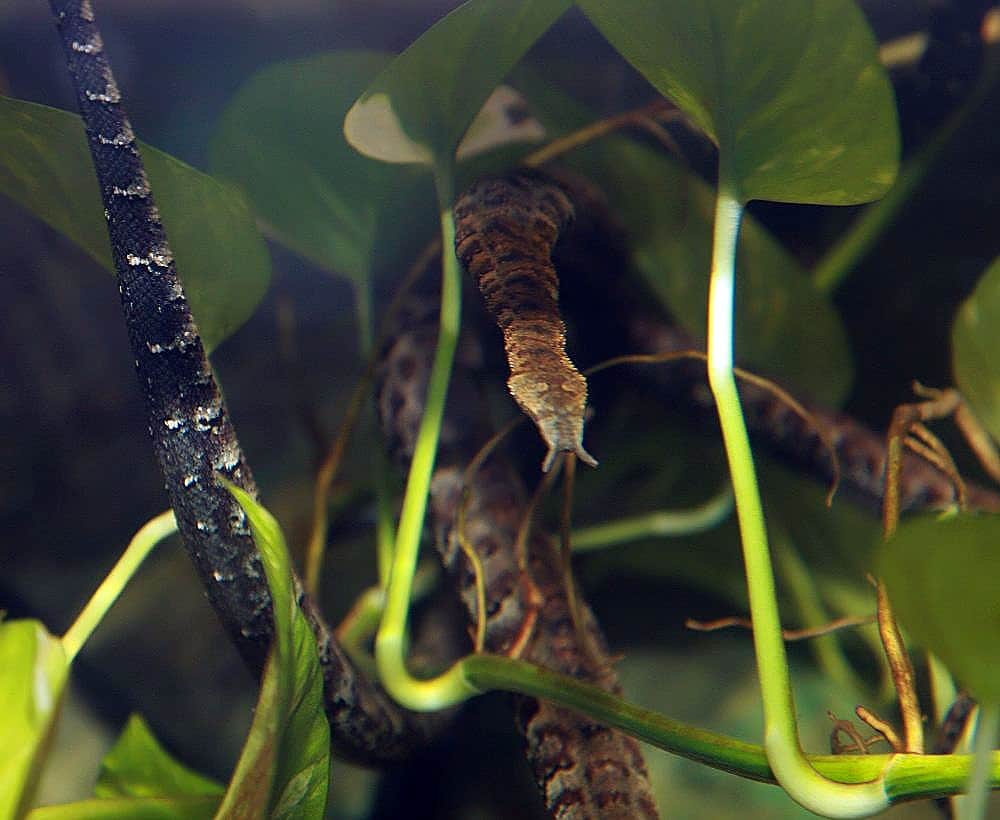
The sole member of the Erpeton snake family. You’ll only find these freaky snakes in the lakes and slow-moving streams of Thailand, Cambodia and Vietnam. This is the only snake worldwide to have these blobby looking tentacle appendages sprouting from their face. The tentacles aren’t just to frighten fishermen, as they’re dense with mechanoreceptors that sense water movements, allowing them to anticipate the arrival of fish. A study found that their keen eyesight was sufficient to grab fish, but when their vision was impaired, they were still accurate hunters.
Tentacled snakes are ambushers, which stay motionless in a specific J-shape with their head curled at the neck. When the fish strays within range, with tentacles on high alert, Erpeton tentaculatum will pounce.
Fish make up almost all of this 54-90cm snake’s diet. Tentacled snakes do have venom, but it’s mild, and the toxins are geared specifically towards fish. The tentacled snake spends its entire life in murky, silty water, and can spend 30 minutes underwater without surfacing for air.
| 5 | Hairy bush viper |
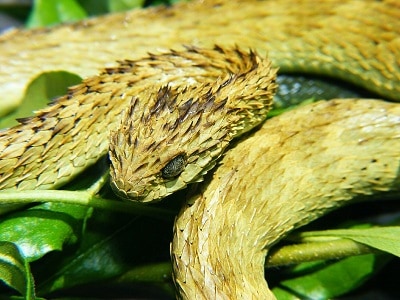
The hairy bush viper is what happens when a cobra gets lonely and breeds with a pinapple. Atheris hispida lives in Tanzania, Kenya, DRC and Uganda (and probably Rwanda) and is one of the wackiest looking serpents on Earth. It looks like a tropical fruit, down to each individual scale being extremely long.
Its massive eyes are another factor in the weirdness. In its obscure forest habitats, they miss nothing, and they’re also extremely colourful. The pupil is vertical, about the width of Sauron’s flaming eye, surrounded by a thin yellow line. The iris is then a mix of many colours with strong hints of blue, contrasting against the yellow scales. Two scales stand between the huge, crystal ball eyes and their slit-like nostrils.
The eyes are for scanning, while the jagged scales have their own purpose of effortlessly climbing trees. The hairy bush viper has a neurotoxic venom which causes more harm than once believed, possibly including haemorrhaging organs. And yes, if you walk past one in a rainforest, they will see you – is their really any doubt?
| 6 | Brongersma’s worm snake |
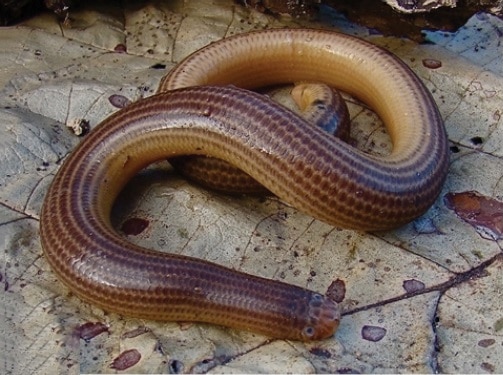
This Brazilian snake shares the silliness of the Arabian sand boa, with seemingly glued on eyes right on top of its head. Amerotyphlops brongersmianus is a burrower, and evolution has somehow decided that the best thing is for its eyeballs to shift upwards millimetres by millimetres over the ages, until they’re permanently angled upwards and optimal for spotting birds.
Brongersma’s worm snake is a very small snake, with a head to tail tip average of just 32.5cm. They live in a world infinitely smaller than our own, of hidden soil tunnels, rotting leaves and twisting underground roots. Though rarely seen, they’re common from Brazil to northern Argentina, and they cope far better with deforestation than other snakes.
The worm snake family was barely researched well into the 2000s, the main reason being that nobody could find them. However, we know that their main prey is ants and termites, working hard and carrying twigs and leaf scraps between their outposts. They eat ants at all stages of development; one study on 14 Brongersma’s worm snakes found that 90.84% of their stomach contents were ant larvea and pupae.
| 7 | Blunt-headed tree snake |
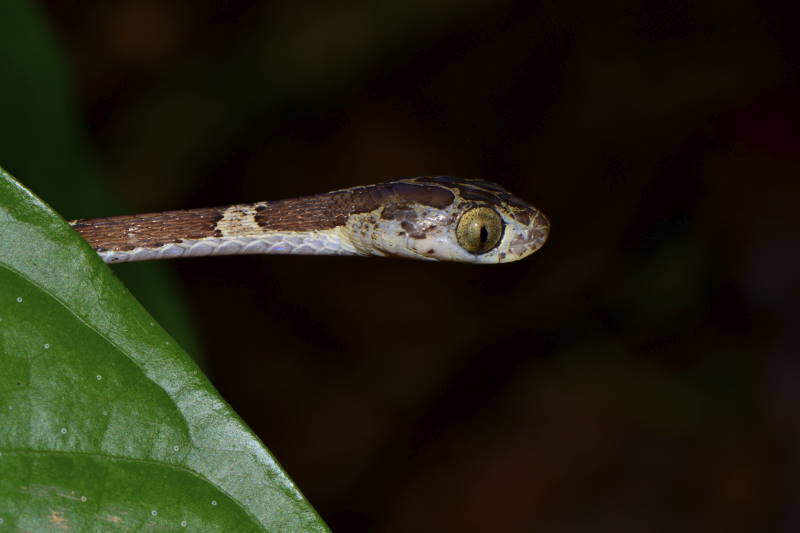
The colour is mesmerizing as well, with a boggy, swampy quality. The iris is usually pale green-brown, but occasionally orange or red speckled, and some have a brown stripe running through the pupils. The blunt-headed tree snake is another forest dweller, and the bulbous eyes help them to see in all directions.
The amazing eyesight also comes into play when hunting. Most snakes require a flicker of movement to set them off, regardless of whether they’re ambushers or prowling snakes that actively hunt. But the blunted tree snake can spot stationary animals, including an anole that hadn’t moved for 93 minutes.
| 8 | Spider tailed horned viper |
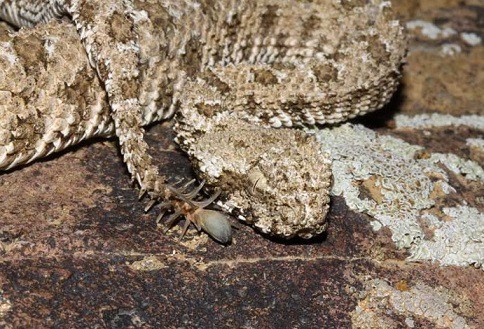
This menacing viper lives solely in the far northwest of Iran. Despite its murderous expression, the spider-tailed horned viper is just trying to survive, and its solution is an unusual tail that mimics the appearance of spiders. All the ingredients are in place: there’s a bulbous blob for its body, and 8 super thin spindly scales for its legs. To complete the deception, Pseudocerastes urarachnoides moves the tail rhythmically in a figure of eight pattern. It’s believed to use this spider tail to lure in birds, as a lark found in its stomach is one of its confirmed prey species (not much research has been done).
Complimenting the spider tail is an extremely craggy desert face, with jagged sandy scales that look like the snake is locked in a perpetual sandstorm. Pseudocerastes urarachnoides was only discovered in 2006, after being classified as a closely related species for decades. They range from 60-90cm, and have the deadly venom of all vipers.
This is a horror taking inspiration from other horrors, a meeting of the nightmares, but fortunately their territory is very small. They may just edge over the border with Iraq.
| 9 | Rhinocerous ratsnake |
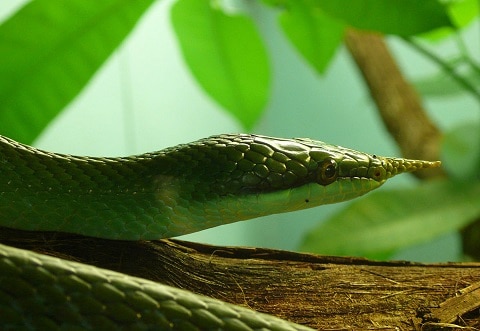
The rhinocerous ratsnake is the luckiest snake in the world: it was born with its own constant poking device to unleash upon anyone who annoys it. It’s no secret how this snake got its name, with both young and adults having hardened pointy scales protruding from its face. Nobody has a clue what the horn is really for, although mating displays are one unproven theory.
This is mostly an arboreal (tree-dwelling) snake which uses its greenness to blend in. Its territory includes Vietnam and the far south of China, and it was first discovered in 1897. Rhinocerous ratsnakes (Gonyosoma boulengeri) measure 100-160cm, and gravitate towards subtropical rainforests, particularly valleys within rainforests with flowing streams. They appear at altitudes of 300 to 1100 metres.
This snake undergoes many shapeshifting changes, as just after birth (measuring 30cm), they’re a brown-grey. At 12 months old they morph into a hard steel grey colour. It takes until 24 months before they reach the adult green to green-blue tone. However, there’s one thing that never changes: the horn.
| 10 | Blunt-headed slug snake |
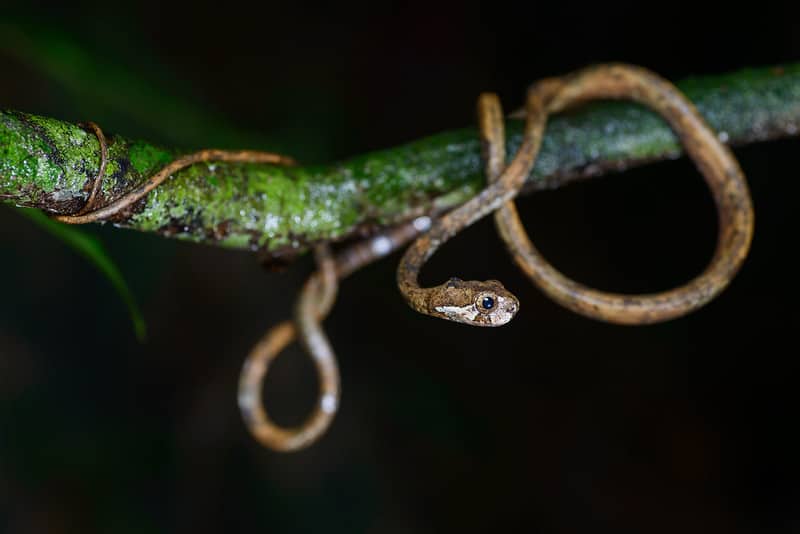
A copycat of the blunt-headed tree snake 10000 miles away. The blunt-headed slug snake (Aplopeltura boa) has embarked upon convergent evolution: when two unrelated subspecies look nearly identical because of occupying a similar ecological niche.
Aplopeltura boa also lives on branches, has an equally twig-like body with an equally long tail, and has equally massive eyes. Its body is a baked brown, as are its irises. The pupils are jet black and round rather than vertical. This snake mainly preys on slugs and snails, so the massive scoping eyes may have evolved to detect these small inconspicuous grubs.
This snake has a wide range in southeast Asia, but is consistently elusive and difficult to find within that range. You can find them in southern Thailand, Myanmar, peninsular Malaysia and Borneo.
This big-eyed snake has a special grinding jaw, adapted to the hardest of snails: those with a hard operculum in addition to their regular shell. Aplopeltura boa rearranges the snail in its mouth, then severs the operculum from the soft body by sawing like a knife and fork. This hard operculum is indigestible even for snail-specialising snakes. The blunt-headed slug snake has a rarity in the snake kingdom: an asymmetrical mouth, with larger teeth on its right side than the left.
